Vegan Buddha Bowl: Brown Rice & Edamame
This vegan buddha bowl includes an array of brightly colored, nutrient-rich plant-based ingredients that are not only healthy, but also incredibly satisfying. The combination of nutty brown rice, protein-filled buttery edamame, briny olives, crunchy pine nuts, and more make this Buddha bowl a delight to eat. The idea is to eat a little bit of each component, so that instead of choosing between a few foods you get to have them all in one sitting! Buddha bowls offer such an amazing variety of flavors and textures that are sure to leave you feeling satiated.
What is a Vegan Buddha Bowl?
Buddha bowls have become extremely popular in recent years due to their vibrant colors and mix of plant-based protein, vegetables, and grains. They are usually vegetarian, although some people do add meat-based protein such as chicken, salmon, beef, or pork to their bowls.
To assemble a buddha bowl, you place your choice of grains, such as brown rice or quinoa, in a bowl before topping it with small portions of vegetables, legumes, and/or tofu. Cauliflower rice would work as a base as well if you are looking for a grain-free option on your rice bowl. These ingredients are usually arranged artfully so that the buddha bowl looks beautiful to the eye. Similar to a salad or stir-fry, buddha bowls always have some kind of sauce that brings all of the ingredients together such as sriracha, peanut sauce, vinaigrette, raita, and more.
Nutrition of Buddha Bowls
While these bowls might take some time to put together, they’re loaded with nutrients like fiber, protein, vitamins, and minerals, and they’re great for leftovers. Just meal prep cooked veggies, grains, and beans ahead of time and combine everything on the days you’re going to be eating the bowl(s).
This particular brown rice and edamame bowl is easy to put together, especially if you already have the ingredients prepared in advance. You can simply combine all of the ingredients in a bowl for a healthy vegan lunch or dinner. The edamame is a vegan protein powerhouse, providing all 9 essential amino acids, and I add cranberries to give the dish a sweet contrast, and Kalamata olives for saltiness and a little umami flavor. Everything is tossed with some lime juice and olive oil and topped with toasted pine nuts for a crunchy texture.
Ingredients
- Short-grain brown rice – or brown basmati or brown jasmine
- Cilantro – or parsley
- Dried cranberries
- Edamame – fresh or frozen (thawed), and blanched
- Kalamata olives – or black olives (or skip if you are not into olives)
- Lime juice – or lemon juice or apple cider vinegar
- Olive oil – or grapeseed oil or avocado oil for a more neutral-tasting oil
- Pine nuts, toasted – or almonds, walnuts, or pecans
- Red pepper flakes – add to taste
Instructions
The beauty of this vegan buddha bowl recipe is that you can use whatever quantity of ingredients you prefer and omit or add ingredients as you like. Here is how to make this buddha bowl:
- Arrange cooked brown rice in a serving bowl.
- Artfully top the bowl with the cilantro, dried cranberries, edamame, and olives on top so that they are in different sections of the bowl.
- Drizzle the lime juice and olive on top of the bowl, and garnish it with the pine nuts and red pepper flakes.
- Before eating the bowl, mix all of the ingredients together to ensure you get a little of everything in every bite!
Flavor Variations
If you would like to change up this buddha bowl recipe, you can feel free to do so by including different ingredients and sauces. Here are some bowl ideas for how you can change this healthy bowl recipe to make other meals that are absolutely delicious.
- Make an Autumnal Butternut Squash Grain Bowl: Instead of using edamame, olives, and lime juice in your grain bowl, you can top it with roasted butternut squash, toasted pecans, and wilted kale. A sauce made with maple syrup and sriracha would take it over the top by adding a hint of sweetness and spiciness.
- Make a Spring Roll-inspired Bowl: For a bowl that is inspired by Thai spring rolls, cooked rice noodles can form the base before being topped with shredded carrots, bean sprouts, fresh mint and Thai basil, and a luscious peanut sauce.
- Make a Crunchy Roasted Chickpea Bowl: Roasted chickpeas are delicious as they become crispy in the oven and add extra crunch. They can be coated with whatever spices you like such as smoked paprika, garlic powder, onion powder, cayenne pepper, chili powder, salt and pepper before being roasted on a large baking tray. Then, a base of whole grains can be topped with leafy greens, fresh vegetables, and a lemony tahini dressing for serving.
- Make a Crispy Tofu Bowl: Air frying tofu gives it a crispy texture that makes it desirable as a plant protein. Consider adding fresh herbs, soy sauce, sesame oil, green onion, and sesame seeds to amplify the Asian inspiration of this healthy buddha bowl.
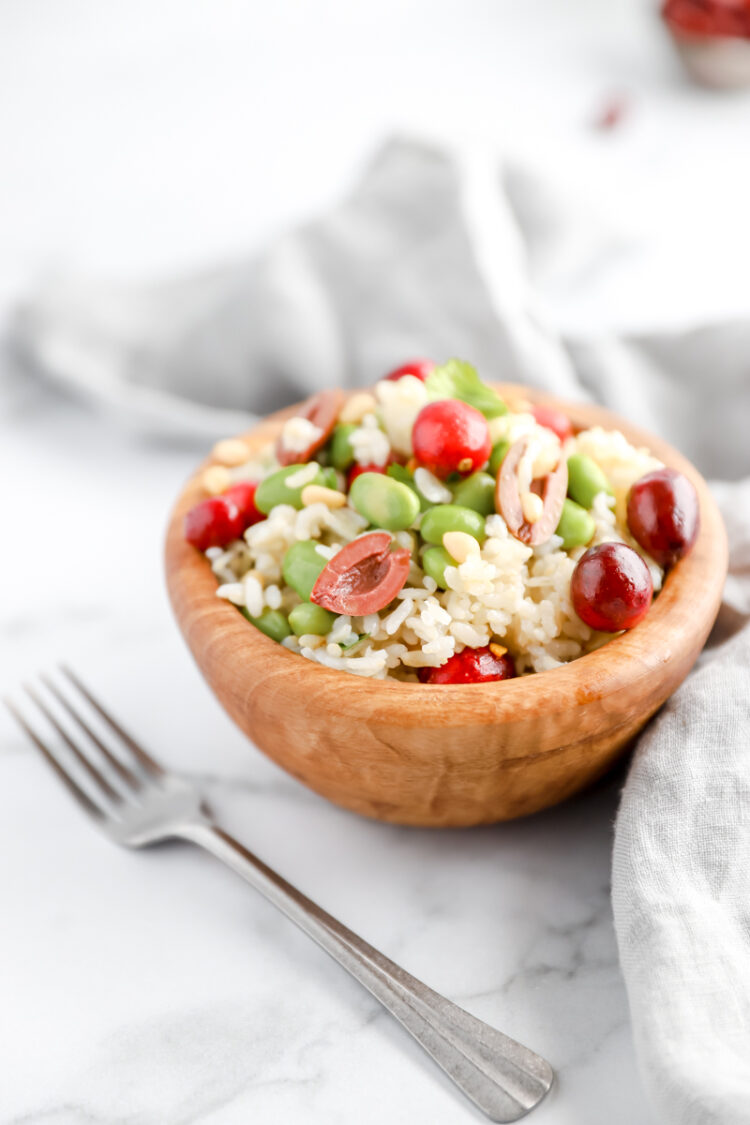
How to Increase Protein in Your Rice Bowl
If you are looking to increase your protein intake, there are plenty of ingredients you can add to your plant-based bowl to make it an extra satisfying meal. Along with the boiled or steamed edamame you use in this recipe, you can include:
- Hemp seeds
- Pressed tofu
- Black beans
- Chickpeas
- Hemp seeds
- Lean protein like chicken breast or fish if you aren’t vegan or vegetarian
- Yogurt if you consume dairy
- Vegan cheese or milk-based cheese if you allow yourself dairy
How to Store This Buddha Bowl Recipe
Rather than storing assembled buddha bowls in the fridge, it is best to prepare the ingredients ahead of time and store them separately so you can assemble your bowl fresh when you need it. The ingredients will stay fresher and the nuts won’t lose their crunch by sitting with the olive oil and lime juice on them.
Simply pre-cook the rice and store it in an airtight container where it will keep for up to 1 week. Alternatively, you can buy frozen rice which you can cook in 3-4 minutes in the microwave.
Meanwhile, you can toast the pine nuts in a pan (without oil) and allow them to cool before storing them in a container. They should stay fresh for up to 1 week this way, although you could also place them in a sealed bag in the freezer if you need to store them for longer.
All of the other ingredients are easy-to-grab items that don’t require any preparation.
FAQ
Yes, usually buddha bowls comprise only of plant-based ingredients like rice or other grains, vegetables, nuts, seeds, tofu, legumes, and some kind of sauce. However, many people will add meat or fish to their bowls as well.
Yes, they are! Since they include a mixture of cooked and raw vegetables, they are loaded with nutrients like fiber, protein, vitamins, and minerals, and comprise many different plant foods making them beneficial to gut health. They also often include many healthy fats which makes you feel more satisfied when you eat them. Since these types of dishes often use plenty of different kinds of ingredients, they are easy to modify for different diets whether you are vegan, vegetarian, dairy free, or gluten free as well.
You can use any healthy grain for a Buddha bowl. In this particular recipe, I use short-grain brown rice, but you can try other brown rice varieties (medium and long-grain). A few of my other favorite “exotic” rices to try include forbidden rice — black rice that originated in ancient China — and red rice, which has recently become popular in the U.S. but has been used in Indonesia for centuries. Both forbidden and red rice contain high levels of an antioxidant called anthocyanin, which is also found in purple and red fruits and veggies like red cabbage, blueberries, and cranberries, and helps reduce systemic inflammation in the body.
Add 1 cup of dry rice to a pot and add water 1 inch above the rice. Bring it to a boil and then cook it uncovered for 30 minutes, checking to see if it’s drying out and adding more water if necessary.
Yes, if you would prefer to add another grain as the base for your buddha bowl, you could replace the brown rice with white rice, rice noodles, soba noodles, quinoa, or even a mixture of fresh salad greens if you are grain-free.
While this bowl recipe includes a wonderful mix of fresh ingredients for amazing flavor, you could really use any vegetables you have on hand that need to be used up. Consider adding roasted sweet potatoes, chopped bell peppers, cooked chickpeas, roasted beets, shredded cabbage, or wilted greens like Swiss chard or spinach.
Yes, if you don’t love the taste of cilantro, you can feel free to omit it or replace it with another herb. Parsley works well as it has a similar texture and appearance to cilantro.
Yes, you can! If you are allergic to nuts or don’t enjoy them, any type of seed makes a wonderful addition. Sunflower seeds, pumpkin seeds, and sesame seeds are all easy to add from the pantry, and don’t require any advance preparation.
Related
For more buddha bowl inspiration, try these recipes:

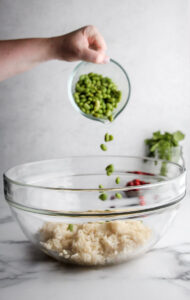
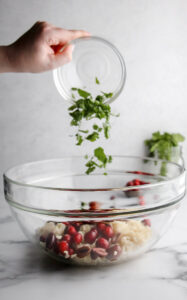
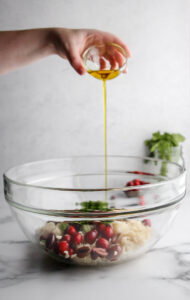
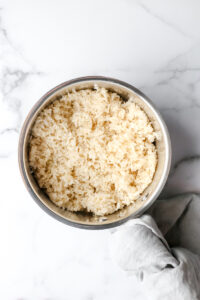
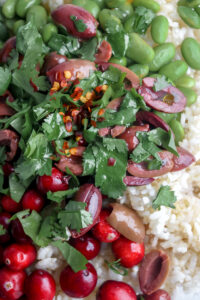
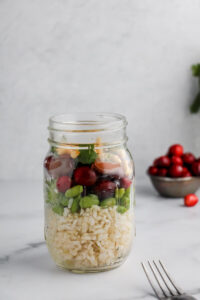
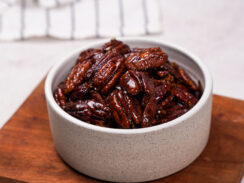
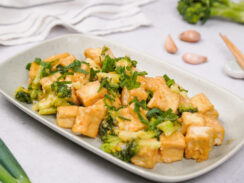
Vegan Spiced Roasted Cauliflower with Vegetables Recipe - Veggiecurean
[…] rice, and now the star of my Spicy Roasted Cauliflower Recipe. This recipe pairs well with my Brown Rice Edamame Bowl and Delicate Squash Green Herb […]